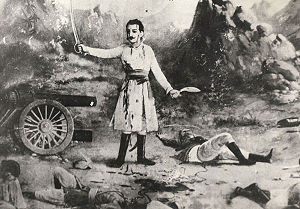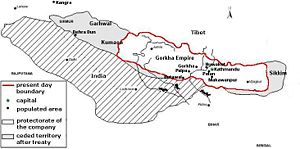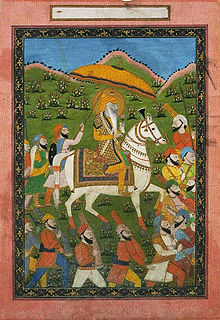Gurkha War
| Anglo-Nepalese War | |||||||
|---|---|---|---|---|---|---|---|
 Balbhadra Singh Thapa, Gurkha commander of the Anglo-Nepalese War | |||||||
| |||||||
| Combatants | |||||||
| British East India Company | Gurkha | ||||||
| Commanders | |||||||
| Francis Rawdon-Hastings David Ochterlony Rollo Gillespie† Bennet Marley John Sullivan Wood |
Bhimsen Thapa Amar Singh Thapa Ranjur Singh Thapa Bhakti Thapa† | ||||||
| Strength | |||||||
| 34,000 at height | 12,000 | ||||||
| Casualties | |||||||
| Unknown | Unknown | ||||||
The Gurkha War was fought between Nepal and the British East India Company between 1814 and 1816. It is sometimes called the Gorkha War or the Anglo-Nepalese War. The Gurkha War marked the rise of the Gurkha kingdom and the consolidation of the British East India Company's influence in Nepal. The open door for growing power in the region came upon the heels of conflict between three small kingdoms, Kathmandu, Patan, and Bhadgaon. Completely focused on warfare among themselves, they became easy prey for the Gurkha empire in 1767. The British East India Company handled the events leading up to the Gurkha War (1814-1816) rather clumsily. Seizing the opportunity to take control of Nepal, the English acted hastily and failed.
The Gurkha rose in that aftermath, becoming a power in Nepal from the 1760s to the early 1800s. In the meantime, the British East India Company had been expanding its sphere of influence. The stage set, Britain and Gurkha went to war. By the time of the Gurkha War outbreak in 1814, Great Britain had learned from experience in India. They showed less haste in sending unprepared troops into battle against the Gurkhas than they had almost forty years earlier. Although the war went badly for the British in the early stages, in the end they won the war and dictated terms of peace in the Treaty of Sugauli of 1816. That treaty came in the aftermath of Britain's loss in the War of 1812 against the United States and the Duke of Wellington's victory over Napoleon at the Battle of Waterloo. Britain rose as a global power, the victory over the Gurkhas marking a milestone in their rise.
Historical background
For centuries Kathmandu, Patan, and Bhadgaon (now Bhaktapur), the three kingdoms of the Kathmandu valley, had quarreled among themselves, too consumed by internal rivalry to take seriously danger from outside their borders. That insularity had, by 1769, enabled Prithvi Narayan Shah the king of Gurkha to conquer the valley, forming the foundations for the modern Kingdom of Nepal.
In 1767, the traditional valley kings, under threat from Gurkha expansion, had requested Great Britain's help. Captain Kinloch responded quickly, failing to make adequate preparations for the campaign. He led 2,500 soldiers against a superior Gurkha army, suffering heavy casualties from combat, malaria, and desertions. Britain's defeat gave the Gurkhas a windfall of captured firearms as well as a misplaced confidence in their war waging abilities against the British.
The conquest of the Kathmandu valley marked the beginning of an rise of Gurkha power throughout the region. They conquered all of eastern Nepal by 1773. By 1788, Gurkha forces had also annexed western portions of Sikkim. In the west, all rulers as far as the Kali River had submitted or been replaced by 1790. Farther west still, the Kumaon region and its capital Almora, had also succumbed to the Gurkhas.
To the north, the Chinese emperor in Peking took steps to stop incursions into Tibet, an outgrowth of a long-standing dispute over trade and control of the mountain passes. In 1792, he sent massive army, expelling the Nepalese out of Tibet to within five kilometers of their capital at Kathmandu. Acting regent Bahadur Shah, (Prithvi Naryan’s son), appealed to the British Governor-General of India, Francis Rawdon-Hastings, Lord Moira for help. Anxious to avoid confrontation with the Chinese, Lord Moira sent Captain Kirkpatrick as mediator, but before he arrived, the war with China had finished. The Chinese forced the Nepalese into signing a humiliating treaty revoking their trading privileges in Tibet and requiring them to pay tribute to Peking every five years.
The Tibet incident had postponed a previously planned attack on the Kingdom of Garhwal, but by 1803 the Raja of Garhwal had also been defeated. He had been killed in the struggle and all his land annexed. Further west, general Amar Singh Thapa overran lands as far as the Kangra, the strongest fort in the hill region, and laid siege to it. By 1809, Ranjit Singh, the ruler of the Sikh state in the Punjab, had intervened and drove the Nepalese army east of the Sutlej river.
The British had also expanded their sphere of influence. The British East India Company's acquisition of the Nawab of Awadh's lands brought the region of Gorakhpur into reach of the Raja of Palpa, the last remaining independent town within the Gurkha heartlands. Suspicion of the Raja‚Äôs collusion with the British led first to his imprisonment by the Gurkhas, then to his assassination. Bhimsen Thapa, the Nepalese Prime Minister (1806‚Äď1837), installed his own father as governor of Palpa leading to serious border disputes between the two powers.
Those disputes arose because of a lack of a fixed boundary separating the Gurkhas and the British. A Border Commission imposed on Nepal by the Governor General failed to solve the problem. Gurkha raids into the flatlands of the Tarai, a much prized strip of fertile ground separating the Nepalese hill country from India, increased tensions. The British felt their power in the region and their tenuous lines of communication between Calcutta and the northwest under threat. Since neither side had any idea of the real border, confrontation between the powers proved inevitable.
War
While the Gurkhas had been expanding its empire into Sikkim in the east, Kumaon and Garhwal in the west and into the British sphere of influence in Oudh in the south, the British East India Company had consolidated its position in India from its main bases of Calcutta, Madras, and Bombay. That British expansion had already been resisted in parts of India culminating in the Mahratta Wars, as well as in the Punjab where Ranjit Singh had his own empire-building aspirations. The British felt an imperative to quickly and successfully conclude the Gurkha war.
When the Kathmandu durbar solicited Gurkha chiefs‚Äô opinions about a possible war with the British, Amar Singh voiced the opposition of many, declaring that: ‚ÄúThey will not rest satisfied without establishing their own power and authority, and will unite with the hill rajas, whom we have dispossessed.‚ÄĚ This contrasts sharply with the prime minister Bhimsen Thapa, who argued, ‚Äú‚Ķour hills and fastness are formed by the hand of God, and are impregnable.‚ÄĚ[1] The Gurkha prime minister realized the Nepalese had several advantages over the British including knowledge of the region and recent experience fighting in the mountainous terrain. The British had numerical superiority and far more modern weaponry.
First campaign
The plan for the initial British campaign called for an attack on two fronts across a frontier of more than 1,500 kilometers (930 miles). In the eastern front, Major-General Bennet Marley and Major-General John Sullivan Wood, would lead their respective columns across the Tarai towards the heart of the valley of Kathmandu. Further east, on the Sikkim border, Captain Latter led a small force in a primarily defensive role. Major-General Rollo Gillespie and Colonel David Ochterlony commanded the two columns in the western front. Those columns faced the cream of the Gurkha army under the command of Amar Singh Thapa. Indian troops made up almost all of the four columns, though Ochterlony’s column alone lacked a British infantry battalion. Lord Moira served as the Commander-in-Chief of the British forces.
The campaign started badly. A day before the Governor-General officially declared war on November 1, 1814, General Gillespie had been killed trying to take the weakly defended fort at Kalanga at the Battle of Nalapani. In the interval before Gillespie’s successor Major-General Gabriel Martindell took over command, Colonel Sebright Mawby managed to take Kalanga by cutting off its water supplies. Soon after Martindell arrived however, the British suffered further setbacks at the hands of Ranjur Singh Thapa (Amar Singh Thapa’s son), at the Battle of Jaithak. Martindell eventually reduced Jaithak to rubble with his guns but, even with vastly superior numbers, he failed to occupy it for fear of counter-attack.
The generals in the east mirrored that pusillanimity with both Wood and Marley reluctant to face the enemy. After two attempts to advance on Butwal, Wood, with superior numbers, feebly retreated and took up a defensive posture at Gorakhpur. His compatriot, Major-General Marley, whose 8,000 strong force had been commissioned to provide the main striking force on Kathmandu, showed even more timidity. After his advance posts at Samanpore and Persa had been wiped out due to lack of support, he stood down in abject inactivity and, on February 10, 1815, ‚Äúunable to endure the irksomeness of his situation ‚Ķ took the sudden and extraordinary resolution in leaving the camp.‚ÄĚ[2]
The company’s hopes now rested on the abilities of Colonel Ochterlony’s force of around 10,000 troops. Unlike the other generals, Ochterlony showed determination, skill, and an ability to adapt to the circumstances. Although no initial decisive encounters took place, Ochterlony slowly pushed Amar Singh’s army higher and higher into the mountains until, in April 1815, the Gurkha general had been forced into his main fort at Malaun.
The ensuing Battle of Dionthal proved the decisive moment in the campaign. Attempts by Amar Singh’s most able lieutenant, Bhakti Thapa, to dislodge the British from the Dionthal ridge overlooking the Malaun fort, failed. Although Bhakti Thapa died in the action on April 16, the fort held out for a while. When news arrived announcing that Almora had fallen to Colonel Jasper Nicolls’ 2,000 strong force of regular sepoys on April 26, Amar Singh Thapa realized the hopelessness of the situation and, threatened by the British guns, surrendered. In recognition of their heroic defenses of their respective forts of Malaun and Jaithak, Ochterlony allowed Amar Singh and his son Ranjur, who had joined him at Malaun, to return home with their arms and men. During the campaign Ochterlony received a promotion to Major General.
Second campaign
After Ochterlony’s successful campaign, the Kathmandu durbar failed to ratify the peace agreement signed on November 28, 1815. That reticence to sign soon led to the second campaign. Unsurprisingly, Lord Moira placed Ochterlony in command of the 20,000 strong invasion force of Nepal. While General Ochterlony advanced towards Makwanpur, simultaneous operations by the chogyal, or king, of Sikkim drove the Nepalese army from the east. Amar Singh Thapa would take no part in the campaign. He had retired to a temple, dying shortly after the war ended.
After the decisive Battle of Makwanpur on February 28, 1816, and the fall of the neighboring fort of Hariharpur (after Ranjur Singh ingloriously abandoned his post), the situation became extremely critical for Nepal. The British threat on the capital Kathmandu compelled the Nepalese to ratify the treaty without any further delay.
Aftermath
The Treaty of Sugauli

The Treaty of Sugauli had been ratified on March 4, 1816. According to the treaty, Nepal would lose Sikkim, the territories of Kumaon and Garhwal, and most of the lands of the Tarai. The British East India Company would pay 200,000 rupees annually to compensate for the loss of income from the Tarai region. The Tarai lands proved difficult to govern, the British returning some of them to Nepal in 1816, while Nepal simultaneously abolished the annual payments.
The Mechi river became the new eastern border and the Mahakali river, the western boundary of Nepal. The Treaty forced Kathmandu to accept a British Resident, a hateful symbol of its reduction to client status in relation to the British administration in Calcutta.
Politic events
Prime Minister Bhimsen Thapa, in collusion with the queen regent Tripura Sundari, remained in power despite the defeat of Nepal. Other ruling families, particularly the Pandes, decried what they saw as Bhimsen Thapa‚Äôs submissive attitude towards the British. The prime minister had been able to retain power by maintaining a large, modernized army and politically dominating the court during the minority of King Rajendra Bikram Shah, (reigned 1816‚Äď1847). Additionally, he froze out the Pandes from power by appointing members of his own family into positions of authority.
When queen Tripura Sundari died in 1832, Bhimsen Thapa began to lose influence. In 1833, Brian Hodgson became British resident, openly favoring Bhimsen Thapa’s opponents, and in 1837, the king announced his intention to rule independently depriving the prime minister and his nephew of their military powers. After the eldest son of the queen died, intriguers falsely accused Bhimsen Thapa of attempting to poison the prince. Although acquitted, the Thapas fell in turmoil. When the head of the Pande family, Rana Jang Pande, became prime minister, he had Bhimsen Thapa re-imprisoned. That final episode proved too much. Bhimsen Thapa committed suicide in August 1839.
For his part, David Ochterlony received thanks of both Houses of Parliament and became the first officer in the British East India Company awarded the GCB. Lord Moira also reinstated him as Resident at Delhi and he lived in the style appropriate to a most senior figure of the Company. After Lord Moira left India, succeeded by Lord Amherst as Governor-General in 1823, Ochterlony fell out of favor.
In 1825, the Raja of Bharatpur died and Durjan Sal usurped the six year old heir to the throne, his cousin, whom Ochterlony supported. When Durjan Sal failed to submit to Ochterlony’s demands to vacate the throne, the British general prepared to march on Bharatpur. The new Governor-General refused to back him and, after Amherst countermanded his orders, Ochterlony resigned, just as Amherst had anticipated. That episode badly affected the ailing general who died shortly after on July 14, 1825. Soon after, Amherst himself came under obligation to do precisely what Octherlony had prepared to do, and laid siege to Bharatpur.
The British erected a 165-foot-high memorial erected in Calcutta in his memory. Sir David Ochterlony’s greatest legacy resided the continuing recruitment of Gurkhas into the British and Indian armies.
Gurkha Recruitment
David Ochterlony and the political agent William Fraser quickly to recognized the potential of Gurkha soldiers in British service. During the war, the British employed defectors from the Gurkha army as irregular forces. In April 1815, his confidence in their loyalty prompted him to form them into a battalion under Lieutenant Ross called the Nasiri regiment. That regiment, later to become the 1st King George‚Äôs Own Gurkha Rifles, saw action at the Malaun fort under the leadership of Lieutenant Lawtie. Lawtie reported to Ochterlony that he ‚Äúhad the greatest reason to be satisfied with their exertions.‚ÄĚ[3]
About 5,000 men entered British service in 1815, most of them Kumaonis, Garhwalis and other Himalayan hill men rather than Gurkhas. Those groups, eventually lumped together under the term Gurkha, became the backbone of British Indian forces.
As well as Ochterlony’s Gurkha battalions, William Fraser and Lieutenant Frederick Young raised the Sirmoor battalion, later to become the 2nd King Edward VII's Own Gurkha Rifles. An additional battalion, the Kumaon battalion, had been raised later becoming the 3rd Queen Alexandra's Own Gurkha Rifles. None of those men fought in the second campaign.
See also
Notes
ReferencesISBN links support NWE through referral fees
- Gould, Tony. Imperial Warriors: Britain and the Gurkhas. London: Granta Books, 1999. ISBN 978-1862072848.
- Michael, Bernardo A. Separating the Yam from the Boulder Statemaking, Space, and the Causes of the Anglo-Gorkha War of 1814-1816. Thesis (Ph. D.)‚ÄĒUniversity of Hawaii at Manoa, 2001. OCLC 123908316
- Rana, Netra R. L. The Anglo-Gorkha War, 1814-1816, 1970. OCLC 135921
- Sinclair, David. History of India. Madras: Christian Knowledge Society's Press, 1884. OCLC 53269008
- Sombre, David O. D., and Nicholas Shreeve. From Nawab to Nabob: The Diary of David Ochterlony Dyce Sombre, 1833-8. Crossbush: Bookwright, 2000. ISBN 978-0948395055.
External Links
All links retrieved June 21, 2024.
Credits
New World Encyclopedia writers and editors rewrote and completed the Wikipedia article in accordance with New World Encyclopedia standards. This article abides by terms of the Creative Commons CC-by-sa 3.0 License (CC-by-sa), which may be used and disseminated with proper attribution. Credit is due under the terms of this license that can reference both the New World Encyclopedia contributors and the selfless volunteer contributors of the Wikimedia Foundation. To cite this article click here for a list of acceptable citing formats.The history of earlier contributions by wikipedians is accessible to researchers here:
The history of this article since it was imported to New World Encyclopedia:
Note: Some restrictions may apply to use of individual images which are separately licensed.
